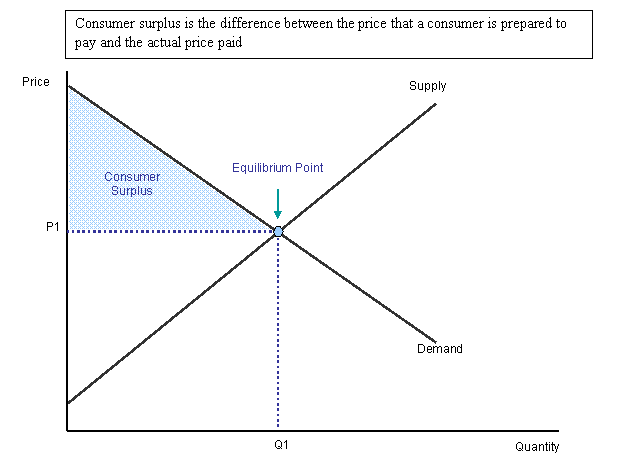Consumer surplus is defined, in part, by the price of the product. Recall that the consumer surplus is calculating the area between the demand curve and the price line for the quantity of goods sold . Assuming that there is no shift in demand, an increase in price will therefore lead to a reduction in consumer surplus, while a decrease in price will lead to an increase in consumer surplus.

Consumer Surplus
An increase in the price will reduce consumer surplus, while a decrease in the price will increase consumer surplus.
Below are two scenarios that illustrate how changes in price can affect consumers' surplus. It is important to note that any shift from the good's pareto optimal price will result in a decrease in the total economic surplus. The total economic surplus equals the sum of the consumer and producer surpluses.
Price Ceiling
A binding price ceiling is one that is lower than the pareto efficient market price. This means that consumers will be able to purchase the product at a lower price than what would normally be available to them. It might appear that this would increase consumer surplus, but that is not necessarily the case.
For consumers to achieve a surplus they have to be able to purchase the product, which means that producers have to make enough to be purchased at a price. If a good's price drops below the market equilibrium for whatever reason, manufacturing the product will be less profitable for the producers. So while more consumers will want to purchase the product because of its low price, they will not be able to. This means the market will have a shortage for that good. This shortage will create a deadweight loss, or a market wide loss of efficiency and value that neither producer nor consumers obtain.
So any increase in consumer surplus due to the decrease in price may be offset by the fact that consumers that want the good cannot purchase it. At some point the benefit from the drop in price will be outweighed by the decrease in the good's availability.
Price Floor
When a price floor is set above the equilibrium price, consumers will have to purchase the product at a higher price. Therefore, fewer consumers will purchase the product because some will decide that the utility they get from the good is not worth the price. Necessarily, this reflects a drop in consumer surplus.